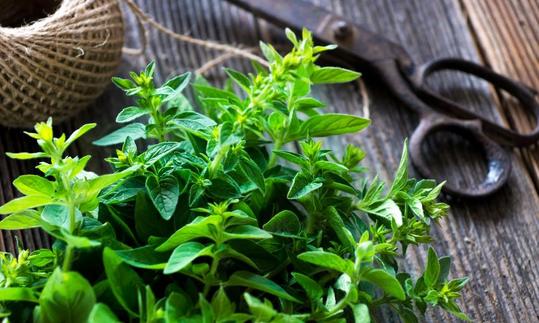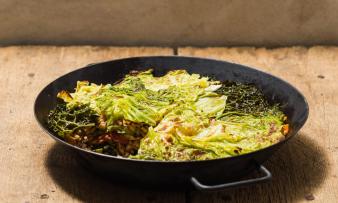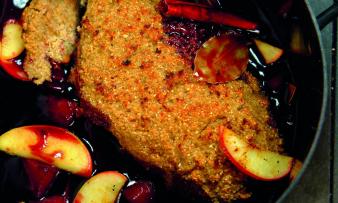Table of contents
Marjoram ( Origanum majorana), also known as sausage herb, is a spice plant native to the Mediterranean region. The herb is ideal for seasoning many dishes, both raw and dried (and preferably in organic quality).
Use in the kitchen
What does marjoram taste like? Marjoram ( Origanum majorana) is an aromatic-smelling herb with a strong, spicy, slightly sweet taste. In contrast to its relative, oregano ( Origanum vulgare), marjoram tastes a little milder. 1
Can you use marjoram fresh? Marjoram can be used fresh (raw), but it can also be used dried or frozen. This article focuses on using the fresh herb. You can find out more about dried marjoram in the related article.
Marjoram - which dishes is it suitable for? The herb is particularly popular in Italian and Greek cuisine and is therefore excellent in Mediterranean dishes such as tomato sauces, pasta dishes, soups and stews. A marjoram vinaigrette tastes great in tomato salad, for example. The leaves also go well with potato dishes such as potato soups, fried potatoes or potato salad. Marjoram also goes well in mushroom dishes, vegetable stews, braised vegetables (e.g. with carrots, red onions, fennel and zucchini) and vegan omelettes. It is also traditionally used for sausages and roasts - there are vegan alternatives for both, such as Barbara's Christmas roast with red wine and plum sauce.
Marjoram also enhances the flavor of recipes containing pulses such as lentils and beans and makes them more digestible. 2 Fresh marjoram is best added towards the end of the cooking time, otherwise it loses a lot of its flavor.
Can you eat marjoram raw? Raw, fresh marjoram adds that special something to all kinds of salads such as leaf salads (e.g. with endive and radicchio), cherry tomato salads (e.g. with a little garlic) or Greek salads with red bell peppers, tomatoes, cucumbers and olives. The herb can also be used to refine spreads (e.g. lentil spread, white bean spread or vegan liver sausage spread) and dips for raw food.
Vegan recipe for potato soup with smoked tofu and marjoram
Ingredients (for 4 people): 1 kg potatoes (starchy), 4 carrots, 2 onions, 2 tbsp rapeseed oil, 750 ml vegetable stock, 100 ml oat cream, 350 g smoked tofu, ½ bunch of fresh marjoram (organic), some salt andpepper.
Preparation: Peel the potatoes and carrots and cut into pieces. Peel the onions and chop roughly. Heat 1 tbsp rapeseed oil in a pan. Sauté the onions until translucent. Add the potatoes and carrots and fry briefly and deglaze with vegetable stock. Bring to the boil and simmer covered for approx. 20 minutes. Cut the smoked tofu into small cubes and fry in a frying pan with rapeseed oil. Rinse the marjoram briefly, shake dry and chop roughly except for a few leaves for garnishing. When the vegetables are soft, add chopped marjoram and puree everything with a hand blender. Stir in the oat cream and season with salt and pepper. Garnish the vegan potato soup with smoked tofu and marjoram leaves and serve.
Vegan recipes with marjoram (raw) can be found under the note: " Recipes that have the most of this ingredient ".
| Not only vegans or vegetarians should read this: Vegans often eat unhealthily. Avoidable nutritional errors. |
Purchasing - Storage
Many supermarkets (e.g. Coop, Migros, Denner, Volg, Spar, Aldi, Lidl, Hofer, Billa) and organic supermarkets (e.g. Denn's Biomarkt, Alnatura) only offer dried marjoram - but all year round. During the summer months, the sausage herb can be bought fresh in some well-stocked branches of Rewe and Edeka. Fresh marjoram is also available in online shops or occasionally at weekly markets.
What is a good marjoram alternative? If you can't find marjoram, you can use other Mediterranean herbs such as thyme or savory as an alternative to marjoram. Fresh savory is used in a ratio of 1:1. Smaller amounts of fresh oregano (eg Greek oregano) and fresh thyme are sufficient, as they have a more intense flavor than marjoram.
The availability of marjoram (raw) varies depending on the size of the store, catchment area, etc. You can find our recorded food prices for the DA-CH countries above under the ingredient image - and by clicking you can see their development at various suppliers.
Storage tips
Fresh marjoram can be stored in a plastic bag or container in the vegetable compartment of the refrigerator for a few days. Wrapping it in a damp cloth will extend its shelf life somewhat. Bunches of herbs will also stay fresh for a few days if placed in a glass of water and look decorative.
Alternatively, you can dry or freeze fresh marjoram (loose or in ice cubes). The dried herb will last for years if stored in a cool, dry place, protected from light and airtight.
Ingredients - Nutritional values - Calories
100 g of fresh marjoram (raw) has a calorie content of 52 kcal. There is little fat (1.1 g/100g), carbohydrates make up 9.8 g/100g and protein 2.1 g/100g. The fiber content is 2.9 g/100g. 3
Fresh sausage cabbage is rich in iron with 13 mg/100g - that makes up 96% of the daily requirement. Fresh green mint and lemon verbena contain a similar amount (12 mg/100g). Dried herbs and spices have significantly more iron, but you consume much less of it. Dried thyme has 124 mg/100g and dried marjoram 83 mg/100g. 3
0.9 mg of manganese are found in 100 g of fresh marjoram (45% of the daily requirement). Fresh rosemary (0.96 mg/100g) and savory (0.82 mg/100g) have a similar content. True sage contains just over four times as much manganese at 4 mg/100g. 3
The calcium content in raw marjoram is 322 mg/100g (40% of the daily requirement). This is similar to that of fresh Greek oregano (310 mg/100g) and fenugreek leaves (328 mg/100g). Significantly more calcium can be found in fennel seeds (1196 mg/100g) or in dried herbs, such as dried basil with 2240 mg/100g or dried marjoram with 1990 mg/100g. 3
The complete ingredients of marjoram (raw), the coverage of the daily requirement and comparison values with other ingredients can be found in our nutrient tables. In the article Nutrients explained you will get a detailed insight into the topic.
Health Effects
Is Marjoram Healthy? Marjoram ( Origanum majorana) is a medicinal plant with various proven pharmacological properties, including antioxidant, antibacterial, antifungal, hepatoprotective, cardioprotective, antiatherosclerotic, antiulcer, anti-coagulant, anti-inflammatory, antidiabetic, antiproliferative, antimutagenic and anticancer properties. The flowering marjoram stems are the medicinal parts. They contain 1 to 2% of the essential oil with terpinene and terpinolene, as well as tannins, bitter substances and carotenes. These substances also give marjoram stomachic, carminative, antispasmodic, analgesic, antipyretic and mildly sedative properties. 4,5
Dangers - Intolerances - Side effects
The acute toxicity test has shown a high level of safety for extracts from marjoram ( Origanum majorana). 4,5
Due to the emmenagogue properties of marjoram (stimulating blood flow in the uterus), its essential oils should not be used during pregnancy and breastfeeding. 4,6
Using the medication for too long (several weeks) and in too high a dose can cause headaches and dizziness. 2 Follow the directions for use.
Folk medicine - natural healing
Marjoram is used in folk medicine to treat a variety of diseases, including gastrointestinal, eye, nasopharyngeal, respiratory, cardiac, rheumatological and neurological diseases. 4 It is used, for example, for allergies, high blood pressure, respiratory infections, diabetes, stomach pain and as an antispasmodic for the intestines. 5
The pharmacist Mannfried Pahlow lists the following possible uses for marjoram tea (made from fresh leaves) as a home remedy: nervous disorders, chlorosis, colds with coughs and phlegm, asthma, digestive problems with flatulence and cramps, colds, hay fever, inflammation of the oral mucosa and bleeding gums. He advises rubbing marjoram ointment around the navel area of babies who suffer from stomach pressure or flatulence. It can also be used to treat colds in babies and small children. Marjoram ointment is also used to treat nerve pain, dislocations and sprains, poorly healing wounds, ulcers and rheumatism. 2
According to writer Deni Bown, marjoram's medicinal properties can be used internally to treat bronchial complaints, tension headaches, insomnia, anxiety, mild digestive problems and painful menstruation, and externally to treat bronchial congestion, muscular pains, arthritis, sprains and stiff joints. 1
Ecological footprint - animal welfare
If you were to consume a third of your daily macronutrient requirement through marjoram, which would be 889 g, you would get (roughly) a CO 2 footprint of 283 g CO₂eq. That is a very good value. In general, you can eat unprocessed plant products without feeling guilty. 11
Studies on the ecological impact of the production and marketing of herbs are rare. However, we were able to find one study in which researchers calculated the carbon footprint and water footprint of oregano ( Origanum vulgare), a close relative of marjoram (Oregano subspecies). According to this calculation, organic oregano had a greenhouse potential of 0.069 kg CO 2 /kg - a very small footprint. The water footprint was also very small, which is of course no surprise for Mediterranean herbs adapted to drought. 13
The carbon footprint of a food product depends on various factors. The type of agricultural production (conventional vs. organic), average vs. seasonal vs. regional production, domestic production vs. import by truck, ship or plane, different types of packaging and whether the product is fresh or frozen all play a decisive role.
Fresh, unpackaged organic marjoram that has not been transported too far is preferable.
Detailed explanations of various sustainability indicators (such as ecological footprint, CO2 footprint, water footprint) can be found here.
Animal welfare - species protection
The oregano species, which also includes marjoram, provides food and living space for a variety of insects. Beneficial insects and natural enemies of pests, the "little garden helpers", are also attracted to the plant. 12,14
Worldwide occurrence - cultivation
Marjoram originally comes from Cyprus and Turkey and is now native to the Mediterranean region. 7 It is cultivated in many countries in Asia, North Africa and Europe, e.g. in Spain, Hungary, Portugal, Germany, Egypt, Poland and France, as a spice and supplier of essential oil. 4,6
can be found in the
Marjoram wild in North African and West Asian countries. In Central Europe, the herb marjoram is cultivated and occasionally found growing wild. 8
"Wild marjoram" is a term for oregano ( Origanum vulgare), and not for wild specimens of marjoram ( Origanum majorana). Oregano and marjoram differ both visually and in taste. Sausage herb has a milder taste than oregano. 1
Growing your own
The herb sausage cabbage grows well in your own garden or on the balcony. As the plant is sensitive to cold, sow around 5 g of marjoram seeds in a cold frame in March. As soon as there is no longer any frost to be expected (from around mid-May), plant the strongest plants 15 cm apart in nutrient-rich, light soil outdoors or in a pot or balcony box. Alternatively, you can buy seedlings from a garden center. The marjoram plants prefer a bright, warm and wind-protected location and need regular watering. 2
Fresh shoots and leaves can be cut or plucked off continuously during the growing season. To dry marjoram, the plant is harvested shortly before or during the flowering period (June to August), as the content of essential oils and aromatic substances is particularly high at this time. To do this, the herb is cut off a hand's breadth above the ground and dried in a bundle in the air. 2, 9
Further information
Marjoram ( Origanum majorana) belongs to the genus Origanum in the mint family (Lamiaceae). Oregano, also known as wild marjoram and also used in cooking, belongs to the same genus. The herbs thyme and rosemary also belong to the same family as marjoram and oregano. Together they are often part of " Herbs of Provence " mixtures.
A relative of marjoram is Syrian oregano ( Origanum syriacum), which is also known as Syrian hyssop or za'atar (zatar, zatar). The term za'atar is used for certain herbal mixtures in which other traditional ingredients are added to the zahtar herb as one of the main ingredients. 10
What does marjoram look like? Marjoram grows into a bushy plant that is 30 to 60 cm tall. The perennial herb has a slanting rhizome, hairy, shrub-like stems and opposite, dark green leaves. These are flattened, oval to broadly elliptical. White or red flowers emerge from the buds. 4
Alternative names
What are other names for marjoram? Common names for marjoram besides Wurstkaut are: Bratenkrätel, Gartenmarjoran, Kuchelkraut, Mairan, Mairon, Miran. 2 Other names are Badkraut, Bratekräutche, Kuttelkraut, Meiran, Mussärol and Mairalkraut.
In English it is called marjoram, sweet marjoram, knotted marjoram.
The following are the various drug names for marjoram: Marjoram herb = Majoranae herba (formerly: Herba Majoranae), Marjoram oil = Majoranae aetheroleum (formerly: Oleum Majoranae), Marjoram ointment = Majoranae unguentum (formerly: Unguentum Majoranae). 2
Other uses
Marjoram oil is used for culinary and medicinal purposes as well as for flavoring liqueurs, perfumes, soaps and hair care products. 1
Bibliography - 14 Sources (Link to the evidence)
| 1. | Bown D. The Royal Horticultural Society. Encyclopedia of Herbs & their Uses. Dorling Kindersley: London; 1995: 319-20. |
| 2. | Pahlow M. Das grosse Buch der Heilpflanzen. Gesund durch die Heilkräfte der Natur. Nikol Verlagsges. mbH: Litauen; 2013: 39, 42-3, 220-3. |
| 3. | USDA United States Department of Agriculture. |
| 4. | Bina F, Rahimi R. Sweet Marjoram. J Evid Based Complementary Altern Med. 2017;22(1):175–85. |
| 5. | Bouyahya A, Chamkhi I, Benali T, Guaouguaou FE, Balahbib A, El Omari N, u. a. Traditional use, phytochemistry, toxicology, and pharmacology of Origanum majorana L. J Ethnopharmacol. 2021;265:113318. |
| 6. | Chevallier A. Das grosse Lexikon der Heilpflanzen. Dorling Kindersley Verlag GmbH: München; 2017: 242. |
| 7. | Powo science kew org: Origanum majorana L. |
| 8. | Infoflora ch: Origanum majorana L. |
| 9. | Mein-schoener-garten de: Majoran ernten und trocknen: So geht’s. 2019. |
| 10. | Alwafa RA, Mudalal S, Mauriello G. Origanum syriacum l. (Za’atar), from raw to go: a review. Plants. 2021;10(5):1001. |
| 11. | Greenpeace Schweiz, Stadt Zürich, Planted Foods AG, Branding Cuisine, Tinkerbelle, Inge, myblueplanet, ProVeg International, Dr. Earth, FightBack und Eaternity. All You Can Eatfor climate - Poster. ayce.earth. 2022. |
| 12. | Walliser J. Attracting beneficial bugs to your garden, revised and updated second edition: a natural approach to pest control. Cool Springs Press; 2022. 210 S. |
| 13. | Litskas V, Chrysargyris A, Stavrinides M, Tzortzakis N. Water-energy-food nexus: A case study on medicinal and aromatic plants. Journal of Cleaner Production. Oktober 2019;233:1334–43. |
| 14. | Stathakis T, Economou L, Barda M, Angelioudakis T, Kati V, Karamaouna F. Potential of Hedgerows with Aromatic Plants as Reservoirs of Natural Enemies of Pests in Orange Orchards. Insects. 17. April 2023;14(4):391. |










Comments